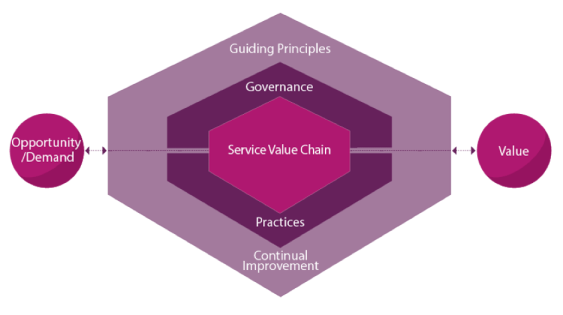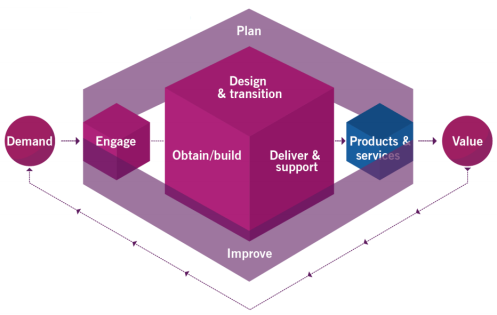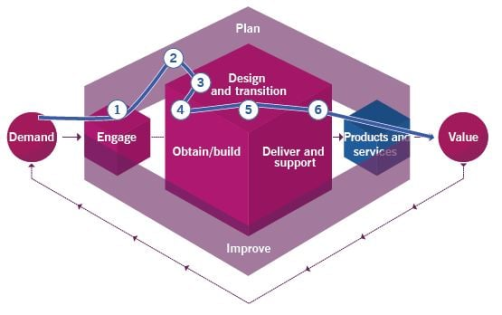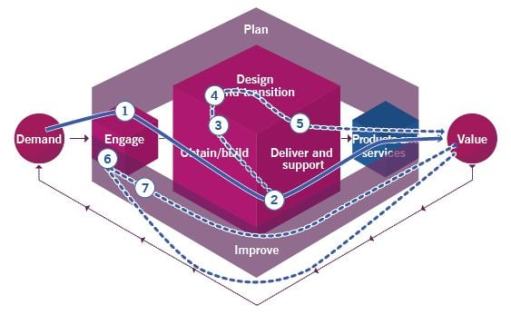The Service Value Chain is the operating model for ITIL 4. But what does this really mean? We look at what it is, how it works, and how you can apply it to transform service management.
Part of our Making ITIL 4 Simple series.
What is the Service Value Chain?
The ITIL 4 Foundation volume describes the Service Value Chain as:
An operating model which outlines the key activities required to respond to demand and facilitate value realization through the creation and management of products and services.
It takes a bit of work to unpack this definition. Basically, the Service Value Chain is the operational model at the core of the Service Value System. It provides a new lens through which to view and manage services—one which compels organizations to frame all activity with two things: the demand that triggers activity and the value it creates.
To understand the Service Value Chain fully, we need to ‘zoom out’ and start with the broader context—the Service Value System:
A model representing how all components and activities of an organization work together to facilitate value creation.
– ITIL 4 definition of the Service Value System

The ITIL Service Value System
The Service Value System is the ‘big-picture’ architecture of ITIL 4, designed to help service organizations take a more holistic, joined-up approach to service management. It shows all the major components that you must have in place to establish high-performance service management capabilities that really deliver for your business:
- 7 Guiding Principles of ITIL to help people think, plan, and work in ways that are productive.
- Governance to keep what IT does aligned with what the business wants to achieve.
- ITIL 4 Practices to manage the discrete capabilities that underpin effective service management (like Incident Management, Problem, Change, Service Design, Portfolio Management, etc) and must work together to deliver value across complex value chains.
- Continual Improvement to make sure things get better over time.
- And of course, the Service Value Chain in the middle.
All of these are important and all of them are inter-connected. Nothing stands in isolation in ITIL 4. An operating model without governance will quickly lose alignment with what your business needs. An operating model cannot function without practices. It won’t get better without continual improvement. And it is unlikely to improve in the right direction without good guiding principles.
Scope of the Service Value Chain
The Service Value Chain is the model which shows how the components and activities work together to achieve the three main goals of service management:
- Run the business – Deliver value from services today (by operating the “Live” Service Portfolio).
- Grow the business – Improve services (incremental innovation) to deliver more value, make customers even happier, reduce costs, and eliminate risks to make services more resilient (high availability).
- Transform the business – Create new services (radical innovation) to satisfy new customer demands (new definitions of value) and bring them into production—redefining the way the organization operates, the products and services it offers to customers, and how it interacts with customers (transforming the customer experience).
![]() KEY TAKEAWAY: The Service Value Chain is where the rubber hits the road; where the work gets done.
KEY TAKEAWAY: The Service Value Chain is where the rubber hits the road; where the work gets done.
How Does the Service Value Chain Work?
There are six kinds of activities in the Service Value Chain. Each one represents a broad activity type into which any and all of your current (and future) service management activities will fit:
- PLAN – All types of planning, at all levels
- ENGAGE – Any and all interactions with people who are external to the service value chain (employees, customers, management, partners/suppliers)
- DESIGN AND TRANSITION – Business analysis and development of new and improved services
- OBTAIN/BUILD – Any new resource brought into the value chain is sourced via obtain/build
- DELIVER AND SUPPORT – Provisioning services and providing help and information
- IMPROVE – Improvements at all levels
Everything you do today and in the future as a service organization will fit into one of these activity types. For every service outcome—whether that is to deliver a service, restore a service, improve a service, or create a new service—it will involve steps of these types. This allows you to map activities to activity types, giving them a consistent structure that can be understood across the organization.

The ITIL 4 Service Value Chain
What are Value Streams?
A Service Value Stream is a series of activities which flows through the Service Value Chain from Demand to Value, taking a path through the necessary value-add steps. Service value streams should always start with demand and always end with the value of delivery to the customer.
A series of steps an organization undertakes to create and deliver products and services to customers.
– ITIL 4 definition of the Service Value System
Value streams set out what work needs to happen (whether that is human labor or automation) to give the customer the result they want. The value-oriented lens of the Service Value Chain ensures that all activities are aligned with demand and there’s no waste—showing the influence of Lean on ITIL 4.
![]() KEY TAKEAWAY: Value streams, defined in terms of the service value chain, clearly answer the question “What do we do when…” for each service management scenario—in a way that everybody can understand.
KEY TAKEAWAY: Value streams, defined in terms of the service value chain, clearly answer the question “What do we do when…” for each service management scenario—in a way that everybody can understand.
Organizations will create multiple value streams to respond to various scenarios. Each value stream takes a different path and may “bounce around” inside the Service Value Chain model before final delivery to the customer.

A simple Service Value Stream mapped onto the Service Value Chain
EXAMPLE SERVICE VALUE STREAMS:
- Service incident response
- Cybersecurity incident response
- Major incident response
- How each service in the service catalog is delivered
- How a service is adapted to meet new requirements
- How new services are created and delivered according to agile and DevOps practices
- How new services are created and delivered according to a traditional waterfall process
Demand is the input that triggers a value stream. From there, the output from the first activity becomes the input for the next, and so on until the desired outcome is delivered to the customer. Different combinations of ITIL practices will be involved in different value streams. Some activities may be performed outside the organization by 3rd party suppliers.

A complex Value Stream mapped onto the Service Value Chain
A value stream may be highly specialized and streamlined to deliver a very specific and well-understood outcome very quickly and efficiently. Or, it may be a more general description of how to tackle a broad set of similar scenarios—requiring some on-the-fly adaptation to fit the specific context. For example, a major incident response stream will have a general shape, but will probably involve an initial emergency planning step to decide the most appropriate approach in this instance.
![]() KEY TAKEAWAY: You can think of the Service Value System as the map of the service ecosystem, the Service Value Chain as the rail network, and Service Value Streams as trains running on that rail network.
KEY TAKEAWAY: You can think of the Service Value System as the map of the service ecosystem, the Service Value Chain as the rail network, and Service Value Streams as trains running on that rail network.
GET STARTED WITH ITIL 4
 Contact us today for a free, no-obligation chat with a qualified consultant
Contact us today for a free, no-obligation chat with a qualified consultant
 ITIL 4 Software: Accelerate ITIL 4 Adoption with Automation
ITIL 4 Software: Accelerate ITIL 4 Adoption with Automation
 Sign-up for blog notifications to make sure you don’t miss out
Sign-up for blog notifications to make sure you don’t miss out
MORE ABOUT ITIL 4
- What’s new in ITIL 4?
- ITIL 4 Guide
- What are the 4 Dimensions of ITIL 4?
- The 7 Guiding Principles of ITIL 4?
- The ITIL 4 Service Value System
ITIL 4© is a registered trademark of AXELOS Limited. All rights reserved.
